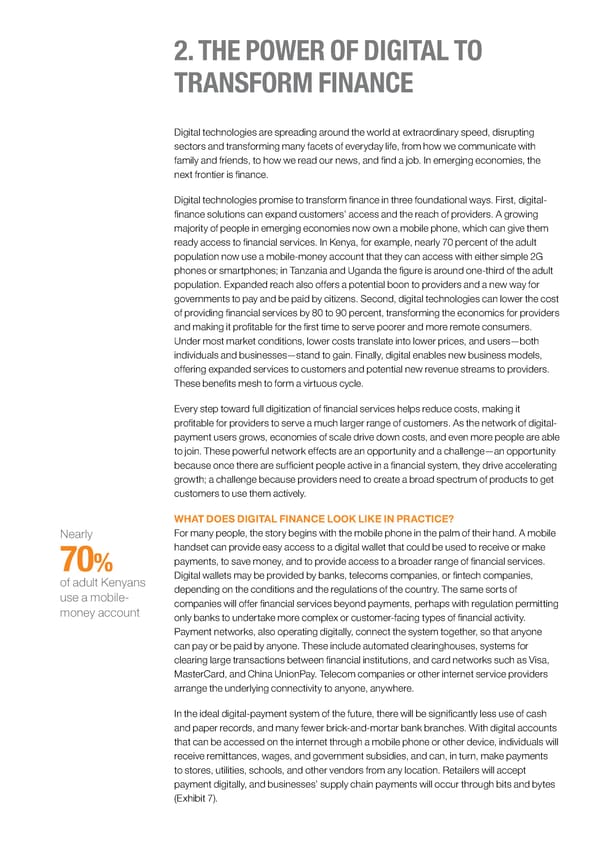2. THE POWER OF DIGITAL TO TRANSFORM FINANCE Digital technologies are spreading around the world at extraordinary speed, disrupting sectors and transforming many facets of everyday life, from how we communicate with family and friends, to how we read our news, and find a job. In emerging economies, the next frontier is finance. Digital technologies promise to transform finance in three foundational ways. First, digital- finance solutions can expand customers’ access and the reach of providers. A growing majority of people in emerging economies now own a mobile phone, which can give them ready access to financial services. In Kenya, for example, nearly 70 percent of the adult population now use a mobile-money account that they can access with either simple 2G phones or smartphones; in Tanzania and Uganda the figure is around one-third of the adult population. Expanded reach also offers a potential boon to providers and a new way for governments to pay and be paid by citizens. Second, digital technologies can lower the cost of providing financial services by 80 to 90 percent, transforming the economics for providers and making it profitable for the first time to serve poorer and more remote consumers. Under most market conditions, lower costs translate into lower prices, and users—both individuals and businesses—stand to gain. Finally, digital enables new business models, offering expanded services to customers and potential new revenue streams to providers. These benefits mesh to form a virtuous cycle. Every step toward full digitization of financial services helps reduce costs, making it profitable for providers to serve a much larger range of customers. As the network of digital- payment users grows, economies of scale drive down costs, and even more people are able to join. These powerful network effects are an opportunity and a challenge—an opportunity because once there are sufficient people active in a financial system, they drive accelerating growth; a challenge because providers need to create a broad spectrum of products to get customers to use them actively. WHAT DOES DIGITAL FINANCE LOOK LIKE IN PRACTICE? Nearly For many people, the story begins with the mobile phone in the palm of their hand. A mobile handset can provide easy access to a digital wallet that could be used to receive or make 70% payments, to save money, and to provide access to a broader range of financial services. of adult Kenyans Digital wallets may be provided by banks, telecoms companies, or fintech companies, use a mobile- depending on the conditions and the regulations of the country. The same sorts of money account companies will offer financial services beyond payments, perhaps with regulation permitting only banks to undertake more complex or customer-facing types of financial activity. Payment networks, also operating digitally, connect the system together, so that anyone can pay or be paid by anyone. These include automated clearinghouses, systems for clearing large transactions between financial institutions, and card networks such as Visa, MasterCard, and China UnionPay. Telecom companies or other internet service providers arrange the underlying connectivity to anyone, anywhere. In the ideal digital-payment system of the future, there will be significantly less use of cash and paper records, and many fewer brick-and-mortar bank branches. With digital accounts that can be accessed on the internet through a mobile phone or other device, individuals will receive remittances, wages, and government subsidies, and can, in turn, make payments to stores, utilities, schools, and other vendors from any location. Retailers will accept payment digitally, and businesses’ supply chain payments will occur through bits and bytes (Exhibit 7).
 DIGITAL FINANCE FOR ALL Page 43 Page 45
DIGITAL FINANCE FOR ALL Page 43 Page 45